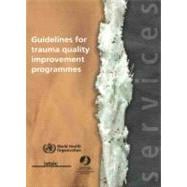
Note: Supplemental materials are not guaranteed with Rental or Used book purchases.
Purchase Benefits
What is included with this book?
| Preface | p. v |
| Contributors | p. vii |
| Acknowledgements | p. viii |
| Executive Summary | p. 1 |
| Introduction | p. 4 |
| Overview of quality improvement | p. 6 |
| Definitions and basics of quality improvement | p. 6 |
| Elements of quality improvement | p. 9 |
| Benefits of quality improvement programmes | p. 13 |
| Review of benefits of trauma quality improvement in the medical literature | p. 13 |
| Experience of trauma quality improvement in low- and middle-income countries | p. 14 |
| Experience of quality improvement in other fields in low-and middle-income countries | p. 16 |
| Status of trauma quality improvement globally | p. 19 |
| Techniques of trauma quality improvement | p. 22 |
| Morbidity and mortality (M & M) conferences | p. 22 |
| Trauma quality improvement committee | p. 23 |
| Preventable death panel review | p. 25 |
| Constituting the panel | p. 26 |
| Preparation of data for the review | p. 27 |
| Specifics of the case review process | p. 30 |
| Inclusion of involved care providers on the panel: potential for bias | p. 31 |
| Preventable death panels: documentation of discussion and analysis | p. 32 |
| Preventable death panels: a summary | p. 32 |
| Tracking of audit filters, complications, errors, adverse events, and sentinel events | p. 34 |
| Audit filters | p. 34 |
| Usefulness of audit filters | p. 36 |
| Complications, adverse events, errors, and sentinel events | p. 37 |
| Classification of errors | p. 40 |
| Statistical methods: risk-adjusted mortality | p. 40 |
| Corrective strategies and closing the loop | p. 44 |
| Guidelines, pathways, and protocols | p. 44 |
| Targeted education | p. 44 |
| Actions for improvement targeted at specific providers | p. 46 |
| Enhanced resources, facilities, or communication | p. 47 |
| Closing the loop | p. 48 |
| System-wide and prehospital quality improvement | p. 49 |
| Role of medical records and trauma registry | p. 51 |
| Appropriateness of different techniques at different levels of the health care system | p. 54 |
| Overlap of these guidelines with other activities | p. 57 |
| Clinical algorithms | p. 57 |
| Patient safety | p. 58 |
| Strengthening of health care management | p. 59 |
| References | p. 60 |
| Annexes | p. 68 |
| Details of literature review of benefits of trauma quality improvement | p. 68 |
| Sample quality improvement tracking form | p. 77 |
| Sample data sheet for use in preventable death panel reviews | p. 79 |
| Sample individual cases for review | p. 81 |
| Table of Contents provided by Ingram. All Rights Reserved. |
The New copy of this book will include any supplemental materials advertised. Please check the title of the book to determine if it should include any access cards, study guides, lab manuals, CDs, etc.
The Used, Rental and eBook copies of this book are not guaranteed to include any supplemental materials. Typically, only the book itself is included. This is true even if the title states it includes any access cards, study guides, lab manuals, CDs, etc.